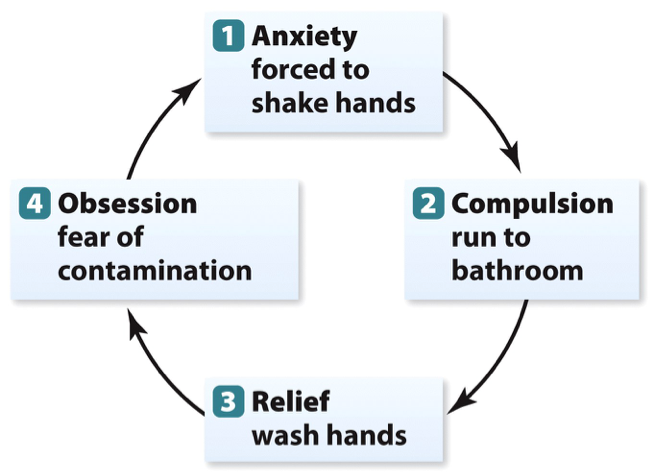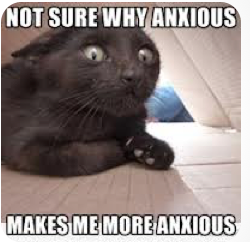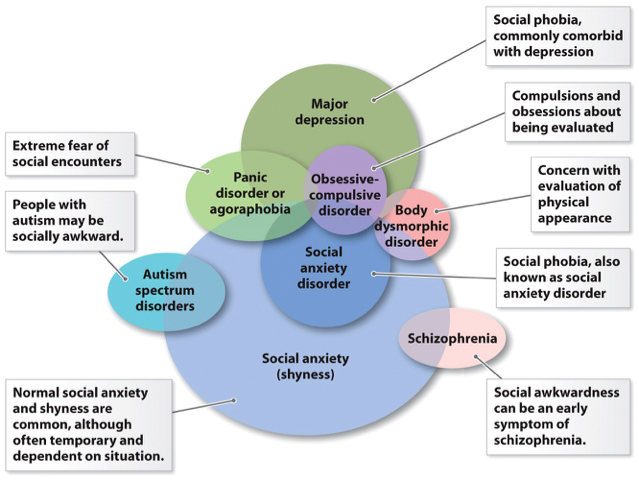Week 9 - Day 2 (Ch 11 Mental disorders pt 2)
Quizlet: https://quizlet.com/_23q13k
Generalized anxiety
-
Generalized anxiety disorder (GAD): a diffuse state of constant anxiety not associated with any specific object or event
-
People with this disorder are constantly anxious and worry incessantly about even minor matters
-
Hypervigilance results in distractibility, fatigue, irritability, and sleep problems, as well as headaches, restlessness, light-headedness, muscle pain
-
Just under 6 percent of the United States population is affected by this disorder at some point in their lives
-
Women are diagnosed more often than men
-
Perhaps on average women are a bit more anxious than males
Post-traumatic stress disorder
-
Posttraumatic stress disorder (PTSD): involves frequent nightmares, intrusive thoughts, and flashbacks related to an earlier trauma
-
At Northern Illinois University in 2008 a lone gunman killed five people and wounded 21. Among a sample of female students, those with certain genetic markers related to serotonin functioning were much more likely to show PTSD symptoms in the weeks after the shooting (Mercer et al., 2011).
-
Those with PTSD often have chronic tension, anxiety, and health problems, and they may experience memory and attention problems in their daily lives. PTSD involves an unusual problem in memory—the inability to forget.
-
A theory is that people who are more prone to PTSD have a smaller hippocampus and it really feels like they're experiencing this traumatic event over and over
-
It really feels to these people that they are experiencing the event
-
The lifetime prevalence of PTSD is around 7 percent; women are more likely to develop the disorder
-
People who have babies tend to experience this too
Panic disorder
-
Panic disorder: consists of sudden, overwhelming attacks of terror
-
Panic attacks typically last for several minutes. Victims sweat, tremble, feel their hearts racing; experience shortness of breath, chest pain; feel dizziness and light-headedness with numbness and tingling in their hands and feet.
-
The experience of the panic is dissasociated from what's actually causing it
-
Ex: someone close to you dies and a month later you have an attack and it feels like for no reason
-
People feel that they are going crazy or that they are dying, and those who suffer from persistent panic attacks attempt suicide much more frequently than those in the general population (Fawcett, 1992; Korn et al., 1992; Noyes, 1991).
-
Affects an estimated 3 percent of the population
-
Women are twice as likely to be diagnosed as men
-
Clear link between panic attacks and agoraphobia
Obsessive-compulsive disorder
-
Obsessive-compulsive disorder (OCD): characterized by frequent intrusive thoughts and compulsive action
-
Obsessions: recurrent, intrusive, and unwanted thoughts or ideas or mental images; they often include fear of contamination, of accidents, or of one’s own aggression.
-
These obsessions aren't wanted. They're often disgusting or repulsive to the obsessor
-
Trying not to think about something makes you think about it more
-
Compulsions: particular acts that the OCD patient feels driven to perform over and over again
-
Gives a sense of relief
-
Generally begins in early adulthood, affecting 1 percent to 2 percent of the population; more common among women
Howie Mandel & OCD

-
Forced to shake someone's hands and then you asociate the fear with the act
Causes of anxiety
-
Cognitive Components:
-
When presented with ambiguous or neutral situations, anxious individuals tend to perceive them as threatening, whereas nonanxious individuals assume they are nonthreatening
-

-
Anxious individuals also focus excessive attention on perceived threats, recall threatening events more easily than nonthreatening events, and exaggerate their perceived magnitude and frequency
-
Cyclical, self-perpetuating
-
Sociocultural Components:
-
Through social learning, a person could develop a fear of flying by observing another person’s fearful reaction to the closing of cabin doors
-
Once learned, a fear might then generalize to other enclosed spaces, resulting in claustrophobia
-
Say your mom is scared of flying, she might vicariously make you scared of flying as a child
-
Biological Components:
-
Children who have an inhibited temperamental style are usually shy and tend to avoid unfamiliar people and novel objects
-
Treat new things as more threatening than they actually were
-
Inhibited children are more likely to develop anxiety disorders later in life
-
Adults received brain scans while viewing pictures of familiar faces and of novel faces
-
One group of these adults had been categorized as inhibited before age 2; the other group had been categorized as uninhibited before age 2
-
Compared with the uninhibited group, the inhibited group showed greater activation of the amygdala while viewing the novel faces
-
Limited style of interacting with novel things will more than likely make you more anxious
-
Biological and cognitive-behavioral factors interact to produce the symptoms of OCD:
-
Anxiety is paired to a specific event through classical conditioning; the person then engages in behavior to reduce the anxiety and the behavior is reinforced through operant conditioning
-
OCD runs in families. OCD-related genes control glutamate, the major excitatory neurotransmitter in the brain causing increased neural firing (Pauls, 2008)
-
The caudate, a structure involved in suppressing impulses, is smaller and has structural abnormalities in people with OCD (Baxter, 2000)
-
OCD can be triggered by environmental factors; a streptococcal infection apparently can cause a severe form of OCD in some young children

Mood disorders
-
Depressive disorders
-
Major depression
-
characterized by severe negative moods or lack of interest in normally pleasurable activities
-
Dysthymia
-
Not severe enough to be diagnosed as major depression, but still active depression
Cognitive components of depression
-
People with depression think negatively about themselves, their situations and about the future
-
Aaron T. Beck refers to these negative thoughts about self, situation, and the future as the cognitive triad
-
A second cognitive model of depression is based on learned helplessness, where people come to see themselves as unable to have any effect on events in their lives
-
The attributions they make for negative events are stable and global rather than situational, temporary and specific, which leads them to feel hopeless
Biological components of depression
-
Studies of twins, of families, and adoptions support the notion that depression has a genetic component
-
Concordance rates between identical twins (more than 70%) are generally around two to three times higher than rates between fraternal twins
Situational components of depression
-
A number of studies have implicated life stressors in many cases of depression
-
Depression is especially likely in the face of multiple negative events
-
Patients with depression often have experienced negative life events during the year before the onset of their depression
Bipolar disorder
-
bpd - a mood disorder characterized by alternating periods of depression and mania
-
manic episodes: characterized by elevated mood, increased activity, diminished need for sleep, grandiose ideas, racing thoughts, extreme distractibility, and excessive involvement in pleasurable but foolish activities
-
Hypomoanic episodes: less extreme mood elevations
-
lifetime prevalence for any type is estimated at around 4 percent
Dissociatve disorders
-
Our thoughts and experiences can become dissociated, or split, from the external world
-
dissociative disorders involve disruptions of identity, of memory, or of conscious awareness
-
These disorders are believed to result from extreme stress
-
Ex: Dr. Jekyll and Mr. Hyde
Dissociative amnesia and fugue
-
Both involve loss of memory
-
dissociative amnesia
-
person forgets an event happened or loses awareness of a substantial part of time
-
Dissociative fugue
-
The rarest most extreme form of dissociative amnesia. Person forgets who they are completely
Dissociative identity disorder
-
Dissociative identity disorder - formerly called multiple personality disorder; consists of the occurrence of two or more distinct identities in the same individual
-
Most people with DID are women who report being severely abused as children
-
chldren cope with abuse by pretending it is happening to someone else
|
generalized anxietydisorder (GAD) |
Dissorder which describes a constant state of anxiety not associated with any specific object or event |
| posttraumatic stressdisorder (PTSD) | Involves frequent nightmares, intrusive thoughts, and flashbacks to earlier trauma |
| panic disorder | consists of sudden, overwhelming attacks of terror |
|
agoraphobia |
Fear of a loss of control and being in public |
|
obsessive-compulsive dissorder (OCD) |
characterized by frequent intrusive thoughts and compulsiveaction |
|
obsessions |
recurrent, intrusive, and unwanted thoughts or ideas or mental images (often include fear of contamination, accidents, and one's own aggression) |
| cognitive components of anxiety | When presented with ambiguous or neutral situations, anxious individuals tend to percieve them as threatening and focus attention on perceived threats |
| sociocultural components of anxiety | Fears developed through observing another person's fearfulreation (such as flying) |
| biological components of anxiety | People with these components of anxiety tend to be shy and tend to avoid unfamiliar people and objects (even as children) |
| Major depression |
characterized by severe negative moods or lack of interest in normally pleasurable activities |
|
dysthymia |
Not severe enough to be diagnosed as major depression, but still active depression |
|
cognitive components of depression |
People with depression think negatively about themselves, their situations and about the future |
|
learned helplessness |
people come to see themselves as unable to have any effect on events |
|
bipolar disorder |
a mood disorder characterized by alternating periods of depression and mania |
|
dissociative disorders |
involve disruptions of identity, of memory, or of conscious awareness |
| dissociative amnesia | person forgets an event happened or loses awareness of a substantial part of time |
| Dissociative fugue | The rarest most extreme form of dissociative amnesia. Person forgets who they are completely |
| Dissociative identity disorder |
formerly called multiple personality disorder; consists of the occurrence of two or more distinct identities in the same individual |
